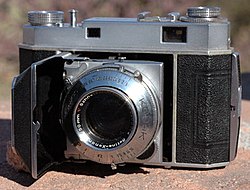135 film
135 film is the official name of the photographic film that is most used today. It is specified by ISO Standard 1007. It was introduced by Kodak in 1934[1] It was made for making still pictures, rather than movies. It is 35mm wide; that is why it is often also called 35mm film.
It quickly grew in popularity. It became more popular than 120 film by the late 1960s. Since then, it has been the most popular photographic film format. Despite competition from formats such as 828, 126, 110 and APS, it remains so today.
Individual rolls of 135 film are enclosed in single-spool, light-tight, metal cassettes. This allows cameras to be loaded in daylight. The film is clipped or taped to a spool and exits via a velvet-covered slot. The end of the film is cut on one side to form a leader, which is to be inserted into a corresponding slot in the camera take-up spool. It has the same dimensions and perforation pitch as 35 mm movie print film. The perforations of 35mm movie camera film are a different shape, but close enough that it will work in most still picture cameras.
135 Film Media
Soviet camera Smena 6 with 35 mm films
Nikon F chrome with eyelevel prism and NIKKOR-S Auto 1:1,4 f=5,8cm lens (1959) – an early SLR system camera
Nikon F6 – The last Nikon F series 35mm SLR introduced in 2004, which remained in production until October 2020
A roll of Kodak 135 film for cameras
This modern film canister uses DX encoding; it is marked with a six-digit barcode which embeds the DX number below a silver-and-black conductive DX Camera Auto Sensing pattern.
References
- ↑ "The History of Kodak Roll Films". Archived from the original on 2004-04-09. Retrieved 2007-11-10.











